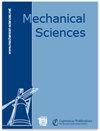A novel mathematical model for the design of the resonance mechanism of an intentional mistuning bladed disk system
IF 1.5
4区 工程技术
Q4 ENGINEERING, MECHANICAL
引用次数: 1
Abstract
Abstract. Bladed disk systems with advanced functions are widely used in turbo-machineries. However, there are always deviations in physical dynamic properties between blades and blades due to the tolerance and wear in operation. The deviations will lead to vibration localization, which will result in high cycle fatigue and accelerate the damage of the bladed disk system. Therefore, many intentional mistuning patterns are proposed to overcome this larger local vibration. Previous studies show that intentional mistuning patterns can be used to reduce the vibration localization of the bladed disk. However, the determination of the resonance mechanism of the intentional mistuning bladed disk system is still an unsolved issue. In this paper, a novel mathematical model of resonance of an intentional mistuning bladed disk system is established. Mistuning of blades and energy resonance are included in this theoretical model. The method of the mechanical power of the rotating blade for one cycle is applied to obtain the resonance condition. By using this theoretical model, the resonance mechanism of an intentional mistuning bladed disk is demonstrated. The results suggest that the ideal results can be obtained by adjusting the intentional mistuning parameter. This paper will guide the design of the dynamic characteristics of the intentional mistuning bladed disk.提出了一种设计故意失谐叶盘系统共振机构的数学模型
摘要刀片式磁盘系统具有先进的功能,广泛应用于机械设备中。然而,由于公差和运行中的磨损,叶片和叶片之间的物理动态特性总是存在偏差。这些偏差将导致振动局部化,从而导致高周疲劳并加速叶片-轮盘系统的损坏。因此,为了克服这种较大的局部振动,提出了许多有意的失谐模式。先前的研究表明,意向调谐模式可以用来减少叶盘的振动局部化。然而,确定有意失谐叶片-圆盘系统的共振机制仍然是一个悬而未决的问题。本文建立了一个新颖的有意失谐叶盘系统共振的数学模型。该理论模型包括叶片失谐和能量共振。采用旋转叶片一个循环的机械功率的方法来获得共振条件。利用该理论模型,论证了有意失谐叶盘的共振机理。结果表明,通过调整有意的误差参数可以获得理想的结果。本文将指导有意失谐叶盘的动力学特性设计。
本文章由计算机程序翻译,如有差异,请以英文原文为准。
求助全文
约1分钟内获得全文
求助全文
来源期刊

Mechanical Sciences
ENGINEERING, MECHANICAL-
CiteScore
2.20
自引率
7.10%
发文量
74
审稿时长
29 weeks
期刊介绍:
The journal Mechanical Sciences (MS) is an international forum for the dissemination of original contributions in the field of theoretical and applied mechanics. Its main ambition is to provide a platform for young researchers to build up a portfolio of high-quality peer-reviewed journal articles. To this end we employ an open-access publication model with moderate page charges, aiming for fast publication and great citation opportunities. A large board of reputable editors makes this possible. The journal will also publish special issues dealing with the current state of the art and future research directions in mechanical sciences. While in-depth research articles are preferred, review articles and short communications will also be considered. We intend and believe to provide a means of publication which complements established journals in the field.
 求助内容:
求助内容: 应助结果提醒方式:
应助结果提醒方式:


